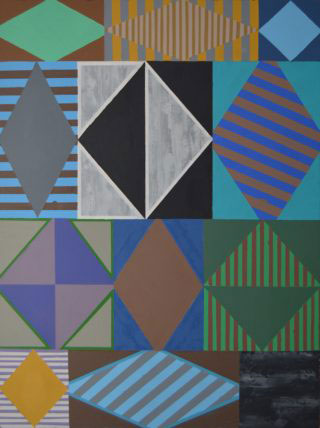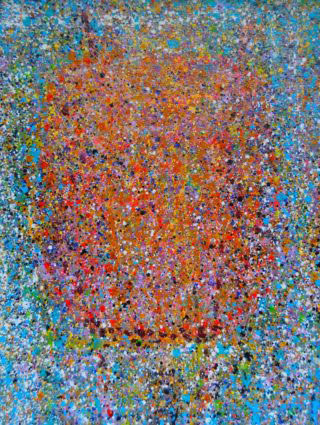Artists Kevin Wixted and Ro Lohin share life harmoniously as husband and wife but when it comes to art making, the pair are at almost aesthetic polar opposites. He meticulously and slowly spreads buttery textures layer upon layer to build his geometric work; she drops a stretched canvas on the floor and flicks tiny drops of paint repeatedly to conjure the silhouettes she sees in their garden in East Marion on Long Island’s North Fork. The couple's art is currently the subject of a compelling two-person show at the South Street Gallery in Greenport.
Lohin’s paintings capitalize on the high-frequency carom of sunlight from L.I. Sound and Peconic Bay. It blasts through the spectrum of her palette, which seems to include essentially every color made. The two artists’ different approaches and the importance of the East End light in their work were the themes of a talk they offered at the show’s opening on July 23, 2016, delivered to an engaged and knowledgeable crowd. In the case of this review, my notes on color, technique and context on the art were also informed by the artists’ supremely clear and often eloquent commentary.
I had spotted Wixted’s large and dynamic Paris Walk when I came through the door, and admired the waxen textures of the thickly applied diamonds and circles in its grid, but the commentary by the artist, a professor of art at Alfred University, made this piece work on a whole new level.
“How do you paint Paris?” he asked, rolling his eyes and lifting his arms in helpless resignation. In an effort to show how he answered the question for himself, Wixted took his audience on a promenade around the gallery, leading from the two oil on paper studies made during his two-month residency there in 2013 to reveal the inner world of Paris Walk.
Guided by a “backstory” Wixted generously offered, the artist’s geometric gem opened up to become a lesson in how an artist (in his word) “assimilates” the following stimuli: medieval glass; the I.M. Pei pyramid at the Louvre in Paris; and the pleasure of buying a tube of pink paint in France and laying it on thick with a tiny palette knife.
.

"Paris Walk" by Kevin Wixted, 2015. Oil on canvas, 48 x 36 inches.
.
Wixted didn't confine his stories to time spent in Paris. He had just been to the big Stuart Davis retrospective at the Whitney and was still jazzed. The affinity is readily apparent in Wixted's technically adroit painting Jerpoint, made before he saw the Whitney show. In Jerpoint, the jaunty rapport of boldly delineated forms is reminiscent of Davis, as well as later Color Field artists. Intimate details demand an extended look.
One of these is the way the burnt sienna ground rises from below at the margins of the sections. Another is a wonderful lower right hand panel in smoky greys and black disguising another diamond. Wixted said he conceives of the parts of the whole as “characters” and allows the colors to interact in a chromatic drama, in a way that reminded me of the work of Josef Albers.
.

"Jerpoint" by Kevin Wixted, 2015. Oil on canvas, 48 x 36 inches.
.
Lohin also revealed her inner world of painting. The direct “backstory” (the term both artists used liberally in their talks) for four admirable paintings on view is the poem by William Carlos Williams, “The Red Wheelbarrow.” This subtle masterpiece of economy and visual impact put Williams in the front ranks of the Imagist movement spearheaded by Ezra Pound. The text in full reads:
so much depends
upon
a red wheel
barrow
glazed with rain
water
beside the white
chickens.
Lohin’s scintillating homage to Williams, brilliantly presented with three of the four paintings closely hung, as if they were a triptych, works wonders with the poem’s own play of colors and sensations as well as the sharp-eyed artist’s registering the shifting sense data of her backyard in East Marion, where both the poem and her own wheelbarrow set off the paintstorm.
“It’s just a little half-acre, but it’s enough for me,” she declared, to sympathetic murmurs from the audience. Calling herself a “perceptual painter” in the tradition of Pierre Bonnard, she noted that she gleefully “draws with the splat, the whack and the flick” of the wrist.
.

"Red Wheelbarrow III" by Ro Lohin, 2015. Oil on canvas, 14 x 11 inches.
.
The paintings need both close and distant viewing. At a distance, in the grand Divisionist tradition (Seurat’s name came up in the talk more than once) the works resolve into the forms of tree branches (one of her largest works) or the wheelbarrow, which hovers in a haze of whites, blues, greens and yellows.
As Lohin acknowledged, “I take every tube of paint I own outside and end up using some of them.”
Up close, a drop the shade of a wine from Bordeaux lands on a drop of scarlet, red on red in the ghostly outline of the wheelbarrow, while the proliferation of blues or greens assembles in an aura around it.
“There’s a time element,” Lohin cryptically observed, “it unfolds but then it is seen simultaneously.” She candidly discussed her struggle with the picture plane and the balance of the planes she is trying to bring to it, a problem Cezanne felt in his own garden when confronted with the foreground, middleground and background and the challenge of wrestling these planes to the single surface of his canvas.
While I was starting to see the busily flickering brush of Gustav Klimt’s landscapes in Lohin’s trees, she brought up a vastly better comparison, Richard Pousette-Dart, who built similarly atmospheric, if more abstract, forms with dabs of pure color. In addition, Pousette-Dart leaned heavily, as Lohin does, on the snowy effect of pure white as a scrim, a technique that, not incidentally, unifies the picture in much the same way as gold did for Bonnard.
Lohin is not the first artist to tee up on a Williams poem. Charles Demuth, a contemporary of Davis, created his painting I Saw the Figure 5 in Gold after reading the raucous Williams poem, “The Great Figure,” about watching a fire truck roar along Ninth Avenue in Manhattan.
Educated at the University of North Carolina at Greensboro, the New York Studio School, and Parsons School of Design, where she earned her MFA, Lohin was once the director of the Lohin Geduld Gallery in New York. She and her professorial husband were equally engaging and authoritative. After she had opened the secrets of the process in her talk, it was time to examine those dots at close range.
I was amazed to note that the red which ought to have dominated a painting titled The Red Wheelbarrow was actually one of the most sparingly used colors in the work. It was overcrowded in one iteration by a range of blues, in another by a halo of greens, making a comparison by the critic Karen Wilkin between Lohin and Joan Mitchell apt here. Throughout the work, Lohin consistently yielded to the rhythmic distribution of pure white.
.

"Red Wheelbarrow I" by Ro Lohin, 2015. Oil on canvas, 14 x 16 inches.
.
With contemporary artist couples, it's interesting to compare and speculate on connections to historic artist couples, adding layers to art history's influence. Although Lohin flicks paint on a canvas placed on the ground, the connection isn't an apt one of Lohin to Pollock and Wixted to Krasner. A better parallel might be to Robert Motherwell and Helen Frankenthaler or Josef and Anni Albers. Then I thought of the Minimalist Robert Mangold, whose inscribed ellipses and circles might accord with Wixted’s geometrical inclinations, and Sylvia Plimack Mangold, whose dreamy tree paintings resemble what Lohin has been doing with the trees in her backyard, and found the comparison that fits best.
In addition to the captivating work of these two artists, praise is due for Amy Worth, who runs the South Street Gallery with Tom Payne, and makes it a point to sponsor artist talks and workshops, building a community of art lovers and makers on the North Fork. On this particular summer evening in Greenport, the idea was working wonders.
_____________________________
BASIC FACTS: “Ro Lohin and Kevin Wixted” is on view July 15 to August 22, 2016, at the South Street Gallery, 18 South Street, Greenport, NY 11944. 631-477-0021. thesouthstreetgallery.com
_____________________________
Copyright 2016 Hamptons Art Hub LLC. All rights reserved.

Proud to be part of South Street Gallery’s ‘stable’—- wonderful article above!!